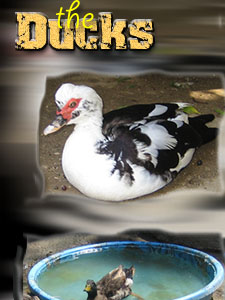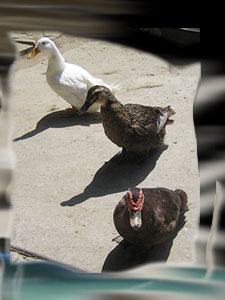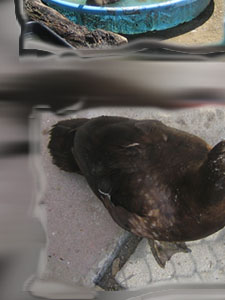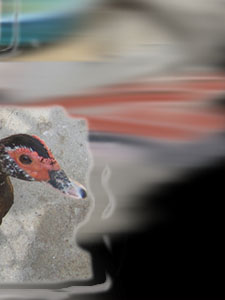
 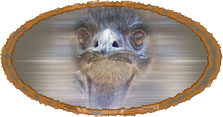 |
|||||
|
My visit to a wildlife foundation
August 10, 2005 In a quiet suburban area of Los Angeles County, hidden on several acres of countryside, a wildlife foundation run by people working closely Animal Control teems with life. The range of species is mind boggling. Here are some of the hundreds of interesting animals I met during my visit. 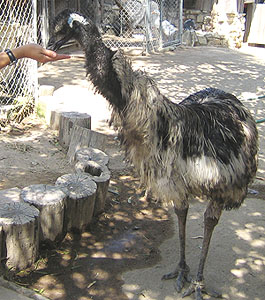
This female Emu has a black throat, and is molting 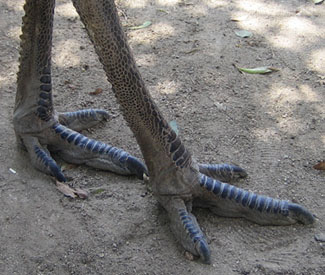
Emu legs and feet are beautiful Emus date back as far as 80 million years, and are believed to originate from Australia. The females are distinctive because of their black throat. Like other birds, they go through regular molting periods. During my visit they were molting, so they look shaggier than normal in the photos. Taking care not to step on any ground dwelling animals, I saw several varieties of desert tortoise. Some on the property are reportedly over 60 years old! Lizards, snakes and other reptiles were kept in special habitats, not running around freely. 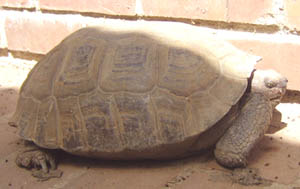
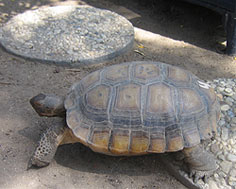
Desert tortoise and others including pond turtles are at home here Who cares for all the animals? Volunteers and part time workers help with the enourmous task of caring for a wide variety of exotic and domestic animals. Many animals have special needs or socialization problems ruling out adoption as an option. It takes hours of work every day by dedicated people to care for so many animals. It's critical not to miss a single feeding or allow any animal to be without water. It's also very important to give the animals as much attention as humanly possible, since they are not in their natural habitats allowing them normal social interaction. All of the animals have been provided with a comfortable, safe place to live rather than be euthanized or left to die in the wild. Some animals can be reintroduced or adopted into families who will give them a good home, like the rabbit (below). Others may have been wild but living in a domestic situation until it didn't work out. These animals can't be placed into permanent homes or released in the wild. It's sad, but I understand why some of the animals will remain on the ranch to live out their lives, like this fox (below). 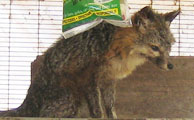
This fox is too old to be reintroduced 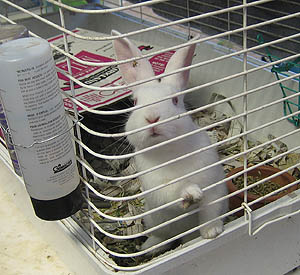 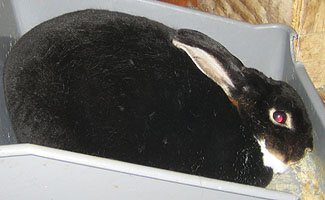
Young male rabbit waiting for a loving home with room to run, the Rex (right) has fur as soft as plush velvet 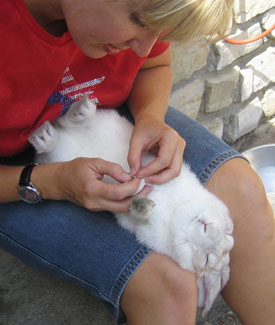
Thunder (the Mini Lop I adopted) is put into a "bunny trance" for her health check Every day, seven days a week, rain or shine, workers prepare the animal's food in a covered outdoor kitchen. Hay, carrots, salad-like mixtures of vegetables, fruit and bagged pre-made foods are made ready for feeding time. Large jugs of water are filled and placed near the cages or habitats until they are systematically filled. Their habitats must be cleaned daily to maintain good health and curb pest problems. 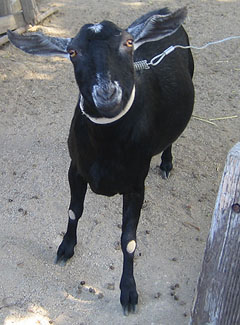 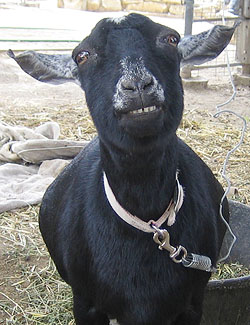
This goat is one of my favorites, what a charmer! The goat is tethered with ample room to move around, and food and water well within reach. The picture on the left was taken on my first visit. The one where he's flirting was taken on my second visit. Quite a few animals recognized me on my return visit and seemed more relaxed, trusting - even affectionate. This miniature horse shown below is a perfect example of gaining trust. He was apprehensive the first time I saw him. 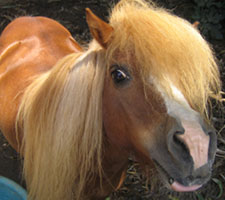 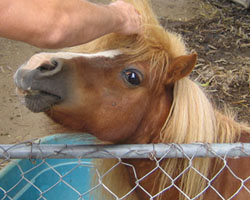
What a darling miniature horse, his whinny sounds like a giggle! 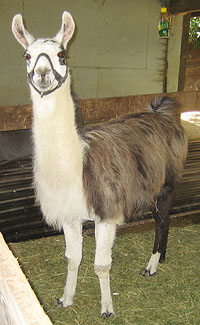 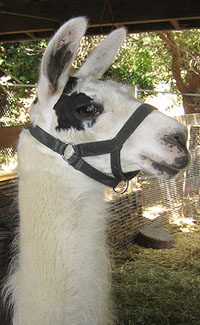
Llamas are generally calm and so pretty Llamas live between 15-20 years and are usually curious and friendly when handled properly. Their poop is called "dung", and they sometimes pile it up to mark their territory. They take "dust baths" by rolling on their backs in the dirt. This helps them maintain their fluffy coat. 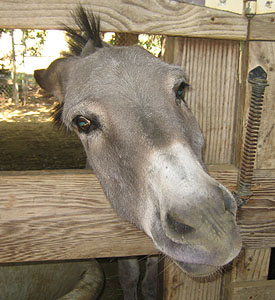
The mule was quirky but friendly 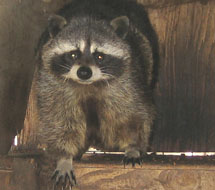
A friendly raccoon It was alot of fun feeding the animals. Most seemed to love carrots. The monkeys were allowed a small bit of popcorn for a treat, and bananas. Still, the carrots were the biggest hit. The monkeys were aggressive when the goodies ran out, as well as the female Emu who puffed her chest up, stomped and made loud booming sounds. Emus can deliver a hard karate-like kick as a defense mechanism. Some of the most interesting animals to watch are monkeys. They are very entertaining, but in no way an animal that is intended to be a pet. That's how many of them got to the ranch, they were too much for their owners to handle. One of them, Igor was unpredictable - sweet one moment and vicious the next. Not an animal you can trust around kids or adults who aren't very well trained. 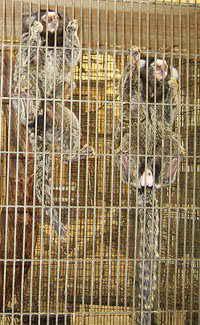 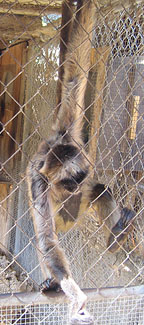
Marmoset and Spider Monkey Learn more about the Marmoset and the Spider Monkey 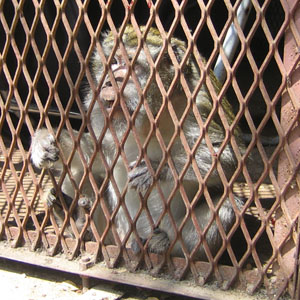
Crab Eating Macaque Learn more about the Crab Eating Macaque 
Marmoset Learn more about the Marmoset 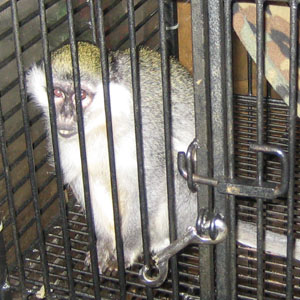
Vervet Learn more about the Vervet 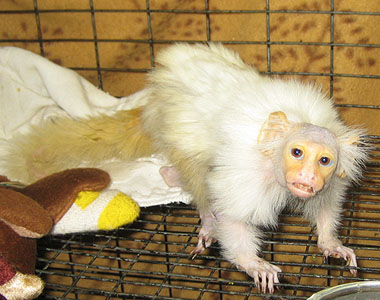
Marmoset Learn more about the Marmoset 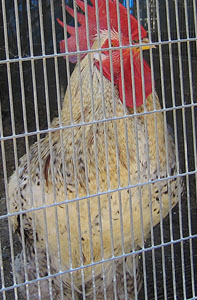 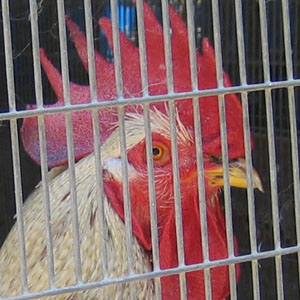
Who said roosters only crow at sunrise? 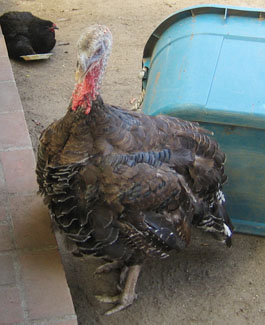
Turkey with a chicken "pigging out" in the background 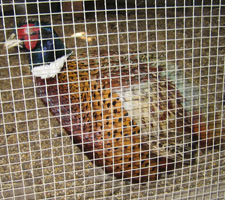 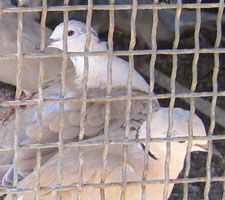
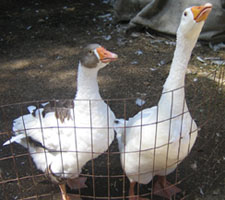 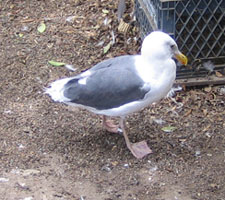
Quail, Doves, Geese and Seagulls and many more birds abound Now for a special treat, a collage featuring some of the ducks I saw on the ranch. It was hard to photograph some the unsocial ones since they ran and hid when I came near. One of the Pekins came right up to me, a clear indication that he was a "dumped duck" rescue and had been with a family in his earliest months. Breeds included Rouen, Mallard, Muscovy, Crested, Pekin, and a few mixed.
If you are able to visit a local wildlife rehabilitation center or care center, please do so, and think ahead. Call ahead to see what they most need or bring donations of towels, appropriate food for the animals, or cash. My local feed store sells carrots in 50 lb bags for under $8.00. I can double my duck food order for just a couple dollars more and donate half to the center. I asked what they needed and they said "anything helps". |
|||||
